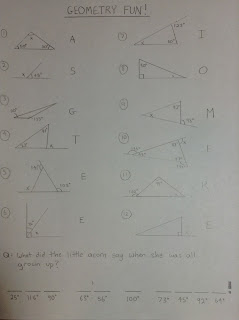1. "A student comes to you right before university applications are due and tells you they need an 85% in your class for the program they want to get into. They currently have a 72%."
This was a tough one for me because I am a very empathetic person and it would make me feel so bad if a student said this to me, especially if it was accompanied by tears. My group discussed the idea of looking at the student's marks to see what's going on. If the student was an 85% student in general, but really did terribly on one unit, then perhaps, as a teacher, you could allow the student to make up the marks for that unit. However, if the students marks are consistently in the low 70s, then there's not a whole lot that can be done. The class discussion and instructor comments brought up the concept of being proactive. Let the students know right from the beginning of the year that these marks are very important, and not a whole lot can be done to adjust marks later on. In doing so, you are letting the students know to take this all very seriously, and there will be no surprises later on when you tell them that you can't adjust their mark.
2. "A student comes to you the day before a test and tells you that she overheard Scott telling a friend that he plans to type his notes and formulas into his graphing calculator. This way, it'll look like he's using his calculator to do math, but he'll really be reading his notes and getting formulas."
My first thought on this was to simply walk around a lot during the test and keep peeking at what the students are doing. That way, Scott would likely feel quite uncomfortable cheating because he would know at any given moment that I could walk by and see what he's doing. However, the class did come up with a couple of other possibilities. First of all, the teacher could have all the students reset their graphing calculators to erase everything in memory. And secondly, our instructor mentioned that one way of solving the problem is to have a classroom set of graphing calculators that are only used for tests. That way, you know that there is nothing saved on them.
There were a few more scenarios that we went through, and all of them were quite challenging! I'm so thankful when instructors give us these types of activities. I don't know about anyone else, but as far as teaching goes, I'm least worried about the actual teaching itself. What I'm most worried about are difficult situations that may arise. They may have to do with marks, cheating, classroom management, etc, but those are the things that I think will be difficult. So, the more exposure we can get to possible classroom scenarios and how to deal with them, the better prepared I will be to go into the classroom.











